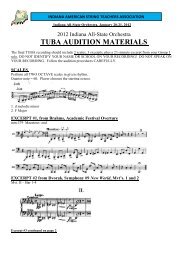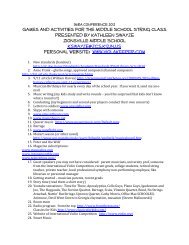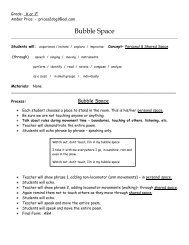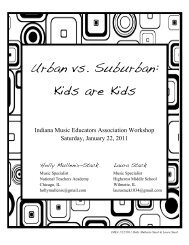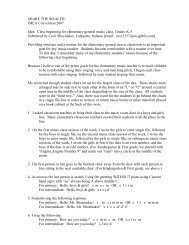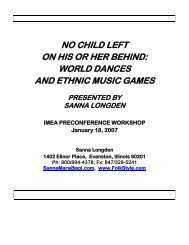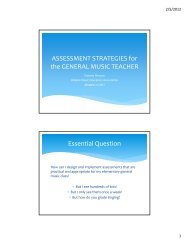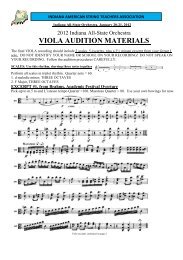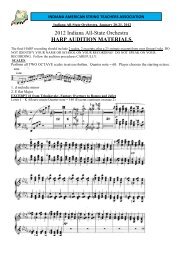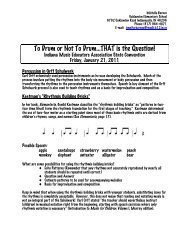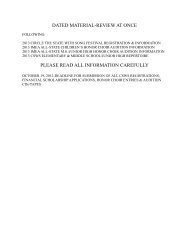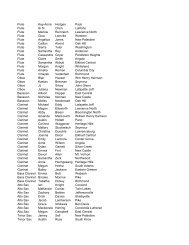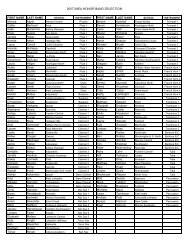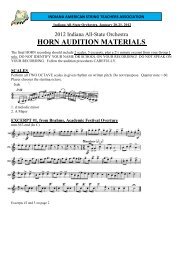Introduction to Orff-Schuwlerk
Introduction to Orff-Schuwlerk
Introduction to Orff-Schuwlerk
Create successful ePaper yourself
Turn your PDF publications into a flip-book with our unique Google optimized e-Paper software.
BethAnn Hepburn<br />
Sponsored by Music Is Elementary<br />
Elementary S.O.S!<br />
Sharing <strong>Orff</strong> Strategies on a budget<br />
IMEA Professional Development Conference 2011<br />
The <strong>Orff</strong> Schulwerk is<br />
A music pedagogical concept that aims <strong>to</strong> stimulate elemental music making<br />
Language, dance and music are equal forms of expression<br />
A work process that gives the participants a great deal of creative freedom,<br />
exploration, play and improvisation that lead <strong>to</strong> a holistic process of creation<br />
A collection of texts, songs and instrumental works that aim <strong>to</strong> inspire children<br />
and teachers <strong>to</strong> sing, play and dance. They were published in five volumes by<br />
Carl <strong>Orff</strong> and Gunild Keetman between 1950 and 1954 under the title Music for<br />
Children<br />
The creation of new elemental music in the collaborative learning environment<br />
We can further divide the philosophy in<strong>to</strong> the following categories: Media, Pedagogy,<br />
Musical Components and Literature Sources.<br />
Media<br />
Movement<br />
Speech<br />
Song<br />
Body Percussion<br />
stamp<br />
patschen<br />
clap<br />
snap<br />
Pedagogy<br />
Imitation<br />
simultaneous<br />
echo<br />
canonic<br />
Exploration<br />
Improvisation<br />
Composition<br />
Unpitched Percussion<br />
Pitched Percussion<br />
Recorders<br />
Musical Components<br />
Emphasis on Rhythm<br />
Pattern and repetition employed<br />
Ostinati as primary accompaniment figure<br />
Complementary rhythms<br />
Gapped scales and modes<br />
Limited harmonic language<br />
Simple Musical Forms<br />
Literature<br />
Original <strong>Orff</strong>/Keetman Source Works<br />
Vols. I-V<br />
Keetman supplements<br />
Other pro<strong>to</strong>type material<br />
Folk Literature<br />
Cultural Materials<br />
Student Improvisation/composition
<strong>Orff</strong> Schulwerk Process<br />
“Singing, Saying, Dancing, Playing” is a common description of the <strong>Orff</strong> Schulwerk approach <strong>to</strong><br />
music making and learning. This participa<strong>to</strong>ry approach combines movement, song, speech,<br />
drama, and instrument playing in an infinite variety of experiences. The combination engages<br />
all of the participants’ senses in the musical “moment”. This approach takes advantage of the<br />
young child’s natural instinct for play and for experiencing music a movement as a whole. It<br />
also allows individuals (teachers, as well as, students) with differing abilities and interests <strong>to</strong><br />
find means for expressing themselves through music.<br />
A primary characteristic of the <strong>Orff</strong> Schulwerk process is a progression from teacherdirected<br />
(imitative or rote) experiences <strong>to</strong> student-generated experiences (improvisation).<br />
This progression occurs both within a lesson and across a curriculum. It is frequently<br />
summarized as follows:<br />
Imitation duplicating or recreating musical gestures and ideas<br />
Exploration discovering the implications, variations,<br />
components, or possible combinations of familiar musical ideas<br />
Improvisation creating unique musical experiences<br />
derived from students’ exploration.
Use of Unpitched Percussion Instruments In an <strong>Orff</strong>-based Elementary Lesson<br />
When working with children, encourage them <strong>to</strong> think of the register (high/low) of<br />
instruments when they choose instruments <strong>to</strong> accompany a poem. For example,<br />
if you start with body percussion sounds, and you want <strong>to</strong> transfer those sounds<br />
<strong>to</strong> instruments, what instrument might you chose <strong>to</strong> replace snaps? or stamps?<br />
Also, encourage children <strong>to</strong> think of timbre when selecting instruments <strong>to</strong><br />
accompany. For example, what instrument might you choose <strong>to</strong> add “color” <strong>to</strong> the<br />
train sound in “S<strong>to</strong>p, Look, Listen”?<br />
The <strong>Orff</strong> Schulwerk approach will often use speech as the media <strong>to</strong> create music ensembles.<br />
SPEECH RHYTHM ENSEMBLE<br />
Music patterns which are melodic or rhythmic that repeat & repeat are called Ostina<strong>to</strong>.<br />
The schulwerk approach layers the ostina<strong>to</strong> patterns <strong>to</strong> create complementary rhythms,<br />
and when played <strong>to</strong>gether create a music ensemble. “Word Chains” based on the<br />
children’s thematic unit, spelling words, rime words from a song, alliterations, <strong>to</strong>ngue<br />
twisters, proverbs, are just a few of the infinite possibilities.<br />
Some Suggestions for Transferring Body Percussion <strong>to</strong> Pitched & Unpitched Instruments<br />
Body Percussion Level Unpitched Percussion Instrument Pitched Instrument<br />
Snap High-pitched ringing metals Glockenspiel<br />
(Finger cymbals, triangles)<br />
Clap Small wooden instruments sop. xylophone/metal.<br />
(wood block, tick-<strong>to</strong>ck, claves)<br />
Pat<br />
two-handed instruments (bi-lateral alternating) al<strong>to</strong> xylophone/metal.<br />
(bongos, temple blocks, maracas)<br />
Stamp Large, Lower-Pitched Instruments Bass xylophone/metal.<br />
(Large hand drums, tubanos, congas)
4 Beat pattern Improvisations within a song context<br />
TONGO<br />
<br />
<br />
<br />
<br />
<br />
<br />
When the students are comfortable with the song, they can add another<br />
musical task<br />
Students create “canoes’ for the work song in a boat (each will have a<br />
different timbre)<br />
Sing the song through as a group, have the students Echo the teacher<br />
4 beat patterns, 4 times<br />
Next, let each student in the “head” of the canoe play 4 rhythms for the<br />
canoe group <strong>to</strong> echo.<br />
Continue repeating the song & the patterns until all students in the boats<br />
have had a turn as the leader.<br />
Students can “hop boats” while playing the singing game, so they can play<br />
several instruments in one class.
Rhythmic Reading, Ensemble Playing, Expressive Speech and Playing<br />
This rhythmic speech piece is a good model for a teacher-directed example that<br />
students should experience, before being asked <strong>to</strong> create accompaniments on their<br />
own, like the next example “Queen of Hearts”.<br />
Speech <strong>to</strong> student-composed rhythms<br />
Explore expressive speech, how <strong>to</strong> say the poem? Scared, bold, whisper?<br />
Learn main chant and create a sample ostina<strong>to</strong> with the students: perform<br />
<strong>to</strong>gether<br />
Transfer <strong>to</strong> Hand Drums: can the expression of the speech transfer <strong>to</strong> the<br />
drums? Expressive speech leads <strong>to</strong> expressive playing.<br />
The Queen of Hearts, she made some tarts<br />
All on a summer’s day<br />
The Knave of Hearts,<br />
He S<strong>to</strong>le the tarts!!<br />
And <strong>to</strong>ok them clean away.<br />
Explore the Newest Gossip in the Kingdom!<br />
Like this is a travesty! The nerve of the knave<br />
The saddest thing that could occur in this good kingdom<br />
Like a 6 th grade girl gossiping<br />
What other ways can you explore the words? Can you add actions?<br />
Next, students create Complementary Ostina<strong>to</strong> inspired by Playing Cards in<br />
small groups<br />
Perform as a Rondo: A B A C A D A (the poem as the A)
Coffee Canon<br />
Source: 150 Rounds for Singing and<br />
Teaching Boosey & Hawkes<br />
Use Hoola Hoops or tape <strong>to</strong> establish the difference of feeling duple and triple.<br />
The teacher walks the beat, around the outside of the hoops.<br />
Ask the students <strong>to</strong> “walk on their laps”, and match your feet.<br />
When you step in<strong>to</strong> a hoop, have the students clap and say the #1.<br />
Bring <strong>to</strong> their attention, how many beats <strong>to</strong>tal they count <strong>to</strong>, before saying #1 again.<br />
What how are the notes grouped? If moving quarter notes, what meter is it?<br />
Once 3/4 is found, have them continue BP in 3/4 and sing song.<br />
Teach song.<br />
When the students are familiar with the song, add ostinati .<br />
Sing the song and explore various body percussion combinations of 3<br />
Using words related <strong>to</strong> drinking coffee as building blocks, have students create an<br />
ostina<strong>to</strong> pattern in 3/4 meter with a partner using the works and body percussion<br />
Transfer <strong>to</strong> “coffee band instruments”<br />
<br />
<br />
Notation Exercise<br />
To aid the student’s rhythmic reading practice, and transfer of sound <strong>to</strong><br />
sight, provide note cards for the students <strong>to</strong> build their rhythm.<br />
Then pass out “instruments” such as coffee cans, cups, spoons, for the students<br />
<strong>to</strong> play their rhythms on.<br />
Beans rest Sugar



